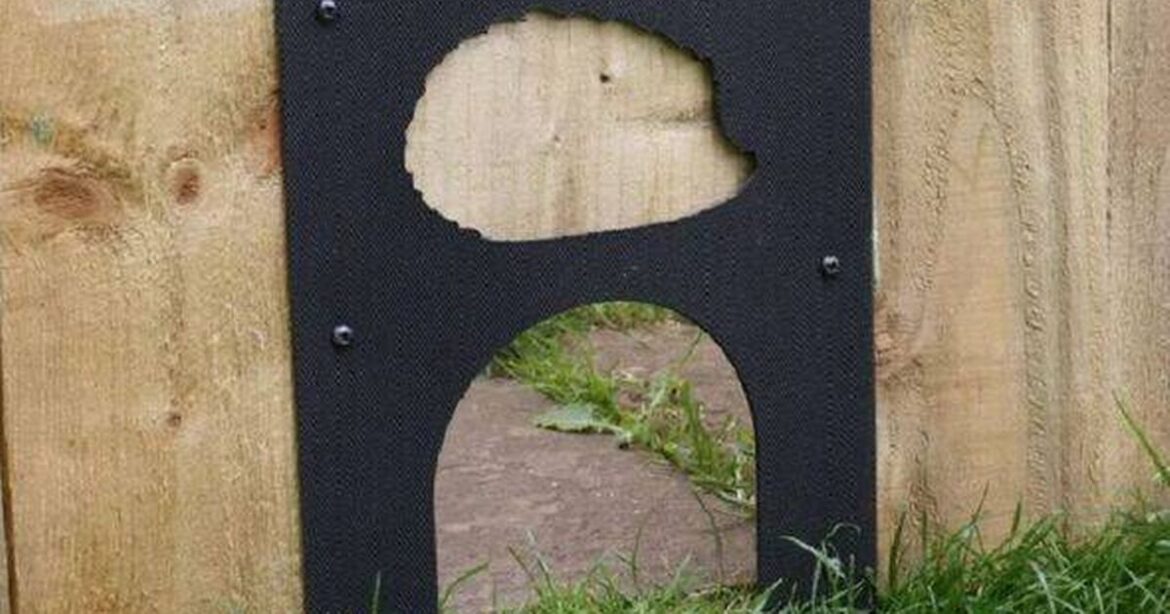Hedgehogs are an endangered species in the UK, partly due to the fact that the spiky creatures are struggling to make their way around built up areas and make their way into gardens A hole in the fence will let hedgehogs through(Image: NHBS)
A hole in the fence will let hedgehogs through(Image: NHBS)
Green-fingered Brits are being told to create escape routes in their garden boundaries this summer to rescue a beloved creature facing extinction. Hedgehog populations have plummeted dramatically across the UK in recent years. The prickly mammals have been devastated by environmental shifts alongside modern gardening practices and contemporary lifestyle choices affecting how we maintain our outdoor spaces.
However, garden enthusiasts should be pulling out all the stops to welcome these spiny visitors during spring and summer months – as hedgehogs serve as brilliant natural pest controllers. These adorable creatures, beyond their undeniable charm, excel at devouring troublesome bugs that gardeners continuously struggle to eliminate from treasured vegetable patches and flower displays.
READ MORE: DNA site that helped woman find long-lost Japanese brother is now under £30
The RSPCA explains that hedgehogs roam extensively but require assistance navigating between garden spaces, reports the Express.
They explained: “Hedgehogs are one of Britain’s most recognisable and well-loved wild animals. Hedgehogs are a gardener’s friend, as they eat beetles, caterpillars, worms and other invertebrates.
“Did you know as many as 10 different hedgehogs may visit a garden over several nights? This could mean ‘your hedgehog’ is actually a number of different ones visiting at different times.
“The European hedgehog is one of around 16 different species found throughout the world. They are also the species that are most often admitted to our specialist wildlife rehabilitation centres.
“Hedgehogs can travel around a mile every night, so they may need help to get into and out of your garden. Try cutting holes in fences, removing bricks from walls, or digging tunnels under the garden boundary. Hedgehogs can travel through gaps as small as 13x13cm, so these gaps don’t need to be large.
“Replacing garden fencing for native hedgerows provides access through your garden for hedgehogs. Hedgerows also provide shelter for other wildlife too. Remember to check with your neighbour before making a highway.”
Tragically, hedgehog populations have plummeted dramatically in recent years, with one key factor behind the decline being the rise of solid, impenetrable barriers and fencing erected around properties.
Wildlife retailer NHBS explains: “Research suggests that this is partly because it is becoming harder for hedgehogs to move freely due to an increase in the number of solid walls and fences being erected around gardens.
“This reduces the available foraging area and so restricts the amount of food that they can eat as well as reducing the possibility of meeting a mate. Creating a hole in a garden wall or fence will allow your local hedgehogs to pass through from garden to garden safely.”
This can be achieved simply by cutting a small, approximately hedgehog-sized opening at the base of your fencing, or alternatively lifting the entire panel by several inches to allow the creatures to squeeze beneath (whilst ensuring the gap isn’t large enough for intruders to crawl through).
Alternatively, you could simply trim a few inches off the bottom of your fence to allow hedgehogs to slip under. While this might seem like an invitation for cats, they can easily leap over six-foot fences, so it won’t increase the number of feline intruders.
If you’re keen on doing it properly, NHBS offers a hedgehog hole fence plate that adds a sturdy metal-enforced gap at the bottom of your fence.
NHBS advises: “A hole measuring 13cm by 13cm is the right size for a hedgehog to pass through but too small for most pets. Once you have made your hole in the fence or wall, you can fix the Eco Hedgehog Hole Plate to the fence, ensuring that the hole does not get blocked or stretched.
“The plate has six screw holes, three along each side, which can be used to fix the plate to your fence or wall. Additional holes can be made in the plastic if required.”

